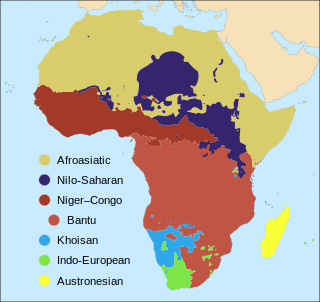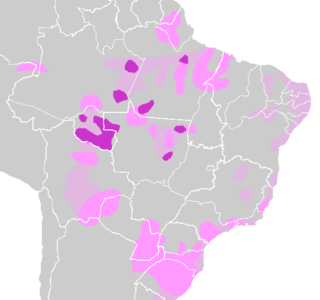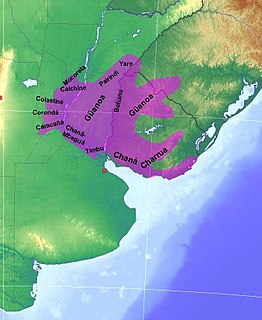
The languages of Africa are divided into six major language families:
Patois is speech or language that is considered nonstandard, although the term is not formally defined in linguistics. As such, patois can refer to pidgins, creoles, dialects, or vernaculars, but not commonly to jargon or slang, which are vocabulary-based forms of cant.

Tupi–Guarani is the name of the most widely distributed subfamily of the Tupian languages of South America. It includes fifty languages, including the best-known languages of the family, Guarani and Old Tupi.
Central Kalapuyan, was a Kalapuyan language indigenous to the central and southern Willamette Valley in Oregon in the United States. It was spoken by various bands of the Kalapuya peoples who inhabited the valley up through the middle of the 19th century. The language is closely related to Northern Kalapuya, spoken in the Tualatin and Yamhill valleys. Dialects of Central Kalapuya that have been identified include:
Efik-Ibibio is the major dialect cluster of the Cross River branch of Benue–Congo. Efik proper has national status in Nigeria and is the literary standard of the Efik languages, though Ibibio proper has more native speakers.

The Yuman–Cochimí languages are a family of languages spoken in Baja California, northern Sonora, southern California, and western Arizona. Although only Cochimí is no longer spoken, going extinct in the late 18th century, all other Yuman languages are nearly extinct.
The Yuat languages are an independent family of five Papuan languages spoken along the Yuat River in East Sepik Province, Papua New Guinea. They are an independent family in the classification of Malcolm Ross, but are included in Stephen Wurm's Sepik–Ramu proposal. However, Foley and Ross could find no lexical or morphological evidence that they are related to the Sepik or Ramu languages.
Anambé, or more specifically Anambe of Cairari, is a possibly extinct Tupi language spoken in Pará, on the Cairari River in Brazil. It is being supplanted by Portuguese.

Several languages are spoken in Sri Lanka within the Indo-European, Dravidian and Austronesian families. Sri Lanka accords official status to Sinhala and Tamil. The languages spoken on the island nation are deeply influenced by the languages of neighbouring India, the Maldives and Malaysia. Arab settlers and the colonial powers of Portugal, the Netherlands and Britain have also influenced the development of modern languages in Sri Lanka.

Itawis is a Northern Philippine language spoken by the Itawis people and is closely related to the Ibanag and Ilocano. Unlike most other Philippine languages, Itawit and its relatives use the consonants /z/, /f/, /v/, and /dʒ/. For example, fefeg (fan), madyan (maid), kazzing (goat), and bavi (pig).

The Charruan languages are a present group of languages once spoken in Uruguay and the Argentine province of Entre Ríos. In 2005 a semi-speaker of Chaná language was found. And have been made efforts at least from 90's decade, for revitalization of the Charrua Language.
The Coast Oregon Penutian languages are a proposed family of three small languages or language clusters on the Oregon Coast that has moderate support. Although much of their similarity is demonstrably due to language contact, linguists such as Scott DeLancey believe they may be genealogically related at a greater time depth. They are part of the much more hypothetical Penutian proposal.

Kyraglydzhek is a village and municipality in the Qusar Rayon of Azerbaijan.
Ngarla is a Pama–Nyungan language of coastal Western Australia. It is possibly mutually intelligible with Panyjima and Martuthunira, but the three are considered distinct languages.

The Kulin languages are a group of closely related languages of the Kulin people, part of the Kulinic branch of Pama–Nyungan.
Ese Ejja, also known as Tiatinagua (Tatinawa), is a Tacanan language of Bolivia and Peru. It is spoken by Ese Ejja people of all ages. Dialects are Guacanawa (Guarayo/Huarayo), Baguaja, Echoja, and possibly extinct Chama, Chuncho, Huanayo, Kinaki, and Mohino. Chunene is "similar" to Ese Ejja, though whether a dialect or a separate language is not clear.
New River Shasta is an extinct Shastan language formerly spoken in northern California. It may have had only 300 speakers before contact, and they soon went extinct; the language is attested in only a few short wordlists. Kroeber regarded them as possibly "nearest to the major group in speech, although [...] their tongue as a whole must have been unintelligible to the Shasta proper."
Lhao Vo, also known as Maru and Langsu, is a Burmish language of Burma with a few thousand speakers in China.
The Wongkumara were an indigenous people of the state of Queensland.
The Muragan were possibly an indigenous Australian people of the state of Queensland. They may have spoken Kunjen, or indeed merely be a mishearing of some Kunjen dialect rather than an actual people.







